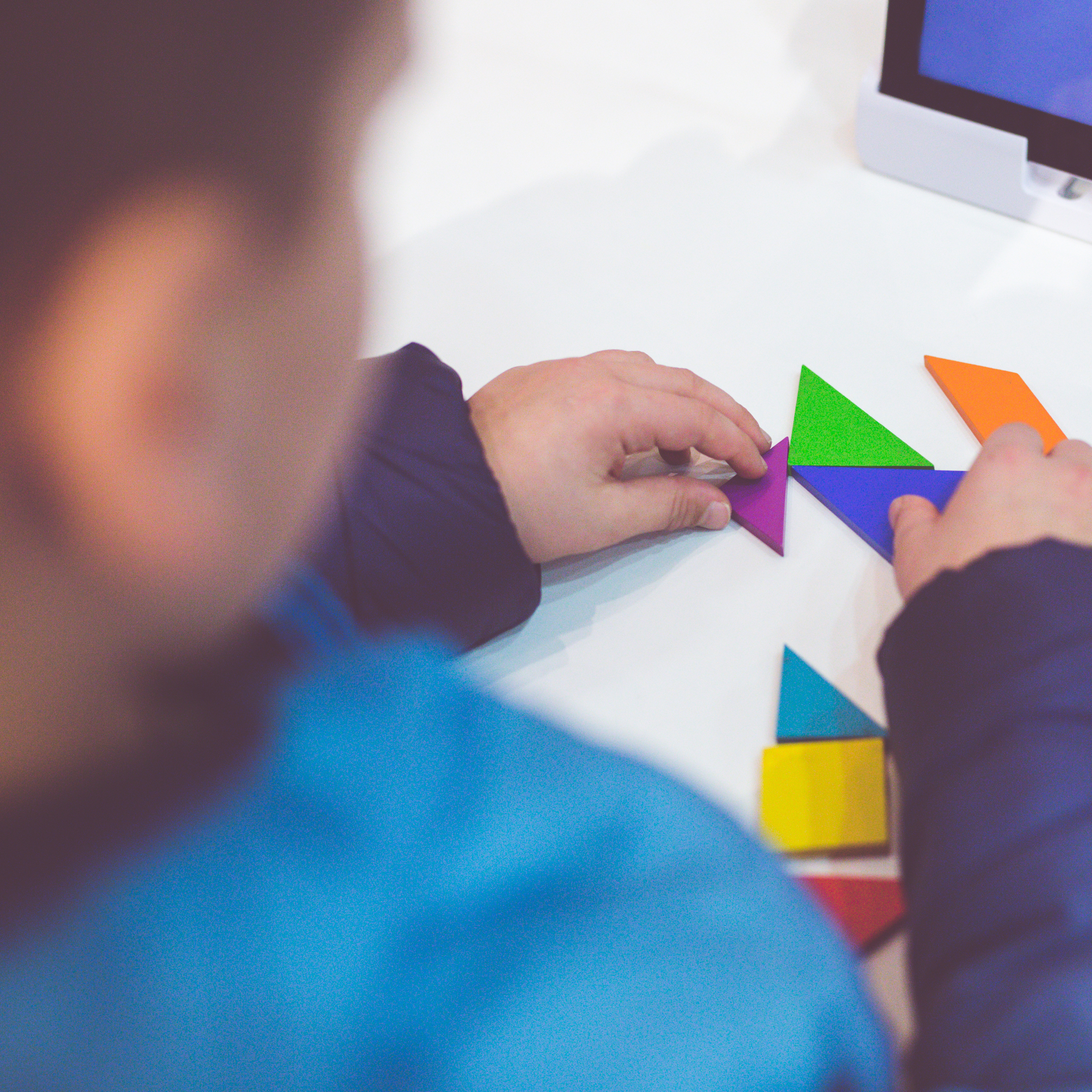Blending Hands-On and Digital Learning Part 2
Continuing with our series on blending digital and hands-on learning, we are going to switch focus today from one-on-one activities to ways to blend hands-on and digital learning in a whole group (classroom) setting.
Keeping in mind Beth Holland’s questions regarding appropriate use of screen time in early childhood, we will be exploring an appropriate, meaningful, and empowering way to teach kids features of 2-dimensional shapes using the VoiceThread app and various tangible 2-dimensional shape resources.
Hands-on Products
Many different products can be used to teach characteristics and features of 2-dimensional shapes. You can look around your classroom or home to find resources. Make sure you have several examples for each shape. If you are just setting up your classroom or looking for materials to purchase, here are some suggestions:

Giant Floor Pattern Blocks – This 49 piece set contains soft, foam shapes in various colors. The only shape missing from this set is a circle. Make sure to supplement this set with circle examples if you use it for shape instruction.
 Stages Lang-O-Learn Colors and Shapes - The Shapes and Colors set features 20 photographic shapes and colors. The cards are labeled on the reverse in 17 different languages, which opens up the activities to students who are learning English as a second language, or who are learning in a foreign language.
Stages Lang-O-Learn Colors and Shapes - The Shapes and Colors set features 20 photographic shapes and colors. The cards are labeled on the reverse in 17 different languages, which opens up the activities to students who are learning English as a second language, or who are learning in a foreign language.
Digital Product
VoiceThread – VoiceThread is an app where you can build conversations around documents. It is also described asa “collaborative, multimedia slideshow”. This tool is used in a wide array of contexts ranging from kindergarten classrooms to architecture firms. You can use this app to upload pictures and videos from your camera and later go back and comment using voice recording, video, or text. VoiceThread uses cloud technology to sync your information from any device where you log in (phone, iPad, computer). In addition to using images taken on mobile devices, you can create a PowerPoint and save the slides as JPGs and import them into VoiceThread. This way you can embed text information along with the images.
App Pros
- It is free*
- You can easily share VoiceThreads through email.
- Multiple points for access (phone, computer, tablet)
- Collaborative
- It is easy to re-record voice comments if they do not come out as desired. Extremely useful when working with 3-5 year olds!
App Cons
- *It is free to a point. You can make up to 5 free VoiceThreads on the free app but then you have to purchase 5 more or upgrade to the Pro subscription.
Combining Hands-on and Digital
Divide your class into shape expert groups. If you are teaching the basic shapes (square, circle, triangle, rectangle) then I would have 4 different groups. You can have two groups for each shape if that makes for better numbers. If you are teaching more shapes, add groups accordingly. For each group have a basket of examples of the shape. Tell the students that they are going to become shape investigators. They are going to have to know everything there is to know about that shape because they are going to teach their class about their designated shape. Give students plenty of time to explore the shapes. After ample exploration time (this can also be done across the span of a few days), have each student come up with something different to say about their shape. Answers can range from “a circle has no sides” to “a cookie is shaped like a circle”.
Students can present their shape to the class. During this time, open up the VoiceThread app and start a new project. For each student that presents, take a photo of them* holding the shape. If you do not have permission to take photos of the students, you can simply take pictures of the shape they are holding.
At a later point you can go back and add voice comments above each child’s picture with their description of the shape. Do not worry about recording during the presentation. You can go back and record during center time, quiet reading time, bathroom breaks, or any other time you can quickly pull a child away.
You can replay the completed VoiceThread as a whole class or set up iPads or computers to have students listen for additional reinforcement. VoiceThreads are also easy to share so make sure to send it to parents to show what their children are learning.
Using VoiceThread in conjunction with hands-on methods of teaching shapes allows for students to be the teacher and share their knowledge with other classmates as well as a way for parents to see and understand what language is being used surrounding certain concepts. Often parents don’t quite understand the depth of knowledge that is required for certain concepts. Voicethread provides that necessary bridge between understanding what is taught in school and how it can be supported at home.
Modifying activity
If your students are not ready for describing shapes, you can do this same activity for labeling or naming shapes. Have students find different shapes around the room. Using the app, take their picture in front of the shape. At that time or later go back and record the student labeling the shape.
Read more of our "Blending Hands-on and Digital Learning" series:

Lindsey Dunn, Ed.M.
Lindsey Dunn received her BS in Applied Learning and Development from the University of Texas at Austin with a specialization in literacy and teaching English as a second language. After graduating, she began teaching in an inclusive kindergarten setting in Katy Independent School District, a leader in educational technology implementation. During her time as a teacher, Lindsey worked on modifying various educational technologies to meet the range of needs of her younger learners. In 2013 she completed her Ed.M at the Harvard Graduate School of Education with a focus in Technology, Innovation, and Education. Following her time at Harvard, she completed a graduate school fellowship with Education Pioneers, a program geared towards training leaders to transforms the education section. As an Education Pioneer Fellow, Lindsey worked with STEMscopes, a science curriculum publisher, based out of Rice University in Houston Texas. During her summer she facilitated over eighty-five prekindergarten through twelfth grade teachers through the training and development of a new curriculum based on the Next Generation Science Standards. Lindsey has also consulted with large educational publishers and video game designers on effective learning design.




